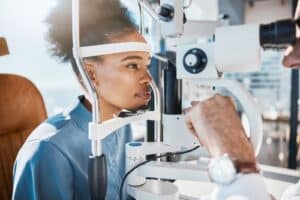Just like you need to see a doctor for your annual physical or dentist for routine dental exams, the same should be true for your eyes. You should have routine eye exams regardless of your age or vision.
Even if you think your eyes are healthy, a routine eye exam is the only way to know for sure. Eye exams are a reliable way to diagnose health issues early so they can be treated effectively.
How often you need an eye exam depends on your vision, age, and risk of developing certain eye conditions. You’ll need to talk to your eye doctor to know how often you should schedule eye exams. Keep reading to learn more about why eye exams are so important and how often you and your children should see an eye doctor.
The Importance of Eye Exams

Eye exams are often the only way to diagnose certain eye conditions in their early stages. Many eye conditions don’t present symptoms until irreparable damage has already occurred. The only way to see that damage is by undergoing a comprehensive eye exam.
Eye conditions are most prevalent in older adults. Eye exams can also often be a way to spot the signs of other medical conditions like diabetes, high blood pressure, high cholesterol, and lupus, amongst others.
Eye exams are also essential for children as they can catch certain eye conditions that develop in childhood. The age groups that need eye exams most often are children and older adults.
But between those ages, you may still need the occasional eye exam, especially if you’re experiencing unusual vision loss or other problems with your vision. Let’s break down the general medical recommendations for routine eye exams by group:
For Anyone with a Refractive Error

If you’re nearsighted, farsighted, or have astigmatism, you should see your ophthalmologist for an eye exam every year. Your age will have nothing to do with whether you should have an eye exam.
Having an eye exam annually if you have a refractive error ensures that your prescription stays current. Monitoring your vision and tracking how quickly your refractive error worsens is also necessary to follow how healthy your eyes are and your risk of certain eye conditions, especially as you age.
For Children

Children should have their eyes examined once a year once they turn six years old. Before this age, they should have one eye exam at six months old and at least another between three and five years old.
If an eye doctor or other medical professional spots any vision issues during these early eye exams, they may need eye exams more frequently, even before turning six. If you notice your child tilting their head a lot, squinting, and sitting very close to the computer or TV, you may want to have their eyes examined before their annual appointment.
You should also inform their eye doctor if they have a family history of certain eye conditions like strabismus or amblyopia. Their eye doctor can help you recognize the early signs of these conditions.
For Those Between 18 and 40

If you’re between 18 and 40, have no refractive errors, and have healthy eyes, you may not need eye exams as often. You may only need eye exams every few years to ensure your eyes stay that way.
However, you should make appointments with your ophthalmologist as necessary if you notice any changes to your vision. If you know you have an increased risk of developing certain eye conditions, you may need routine eye exams more often.
These become even more important once you turn 40, as this is when many age-related eye conditions begin. Be sure to keep your eye doctor updated about your medical history so they can accurately assess your risk for eye disease.
For Adults 40-60
The American Academy of Ophthalmology recommends that adults receive a complete eye exam once they turn 40. You may need eye exams more frequently if you’re at exceptionally high risk for certain eye conditions.
Just being over 40 puts you at higher risk for eye conditions. There are also quite a few other things that can put you at higher risk for eye conditions, including:

- Diabetes
- High blood pressure
- Heart disease
- Obesity
- Frequent direct exposure to sunlight/UV light
- Tobacco use
- Extended use of corticosteroids
- Family history of eye disease
- Severe nearsightedness or farsightedness
Your ethnicity can also be a risk factor. If you’re Caucasian, you’re at higher risk for age-related macular degeneration (AMD). If you’re of African, Hispanic, or Native American descent, you’re at higher risk for glaucoma and diabetic retinopathy.
You’re also at a slightly higher risk of developing angle-closure glaucoma if you’re of Asian descent. Angle-closure glaucoma is a rare form of glaucoma.
Your eye doctor can assess your risk as long as you’re open and honest about your personal and family medical history and recommend eye exams accordingly. But even if you’re otherwise at very low risk for eye conditions, the older you get, the higher your risk becomes.
For Adults 60+

Regardless of any other risk factors, you should see an eye doctor at least once every two years once you turn 60. If you exhibit other risk factors, you may need to have an eye exam once a year.
If you’re at very high risk, you may even need an eye exam more than once a year. Again, your eye doctor can make specific recommendations, but at a minimum, you should see them once every year or two after you turn 60.
To have routine eye exams at all, though, you need to have an eye doctor. If you don’t have one, now is the time to find one. Start by scheduling an appointment at Traverse City Eye in Traverse City, MI, to begin making your eyes a priority!
